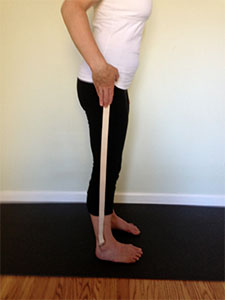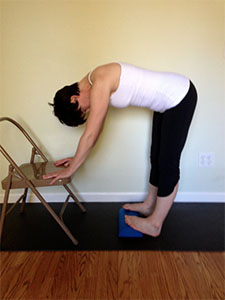Tips For Promoting Cardiovascular Health, Part 1
In our recent workshop on “CARDIOVASCULAR HEALTH” Tiffany and I discussed a variety of ways to keep our cardiovascular system healthy. While we felt satisfied with our efforts to cover most of what we’d wanted in the workshop, we also realize that it was a lot of info to pack into a 2 hour workshop, especially when we were simultaneously teaching a posture sequence new to many of the students who attended.
So I wanted to post some of the content we presented during the workshop to serve as a review for those who attended and as a reference for those who weren’t able to make it. Here is the first part of that content.
What does the C.V. system do?
Before we can understand how to keep the C.V. system healthy, we need to be clear about what it does. The most essential role of the C.V. system is to deliver oxygen and nutrients to all of the tissues of the body and to help move cellular wastes from those tissues back into the lungs and into the lymphatic system for removal. The C.V. system is also important in maintaining consistent body temperature and fluid balance.
What makes up the C.V. system?
The C.V. system is made up of the heart, blood and blood vessels. Most of us think of the heart as the primary worker of the C.V. system, but this is an oversimplification. The vast webbing of aortas, arteries, arterioles and capillaries is a prolific network that fills up a great deal of space in the body, mostly within our muscles. It is therefore difficult to separate our cardiovascular system from our musculosekeltal system. The two systems are interrelated.
What moves blood through your C.V. system?
The heart is not the only muscle that pumps blood. Our blood is moved by the pumping of ALL of our muscles!!! In fact if our heart had to do all of the work of moving blood through the body we would wear this muscle out very quickly. Most of the work of pumping blood through the body is done by muscles other than the heart.
When we perform different movements the various muslces in our body contract and relax to move our bones and generate those movements. This contracting and relaxing of our muslces is what pulls blood out of the blood vessels and into our tissues and pulls blood out of our tissues and into our blood vessels and lymphatic system. Therefore the more muscles we move on a daily basis, the better our cardiovascular health. If we don’t move our bodies in a variety of ways most our cells don’t get fed and cannot excrete their wastes. This leads to degredation of our tissue and eventually disease.
“Sitting Kills!” i.e. “Being Stationary So Much of the Time Kills”
If we are not using our muscles, either because we are not moving very much or our exercise of choice is repetitive and does not vary, then our heart ends up doing all the work. This puts undue stress on the heart. We could run for 1 hour a day and sit for 8 hours and have used very little of our cardiovascular system. Yet sitting in and of itself is not the problem, it is being in one position, using very little muscle, that is the problem. The more muscles we use the healthier the cardiovascular system. Thus the more movements we perform with frequency the healthier our C.V. system.
Keeping our cardiovascular system healthy is achieved through frequent & varied movement throughout the day, not just exercise!
There is a big difference between movement and exercise. A great analogy is that this difference is like the difference between food and vitamins. We can easily understand that we need a varied diet of different foods to live and thrive. If we only took vitamins, regardless of the need we might have for those vitamins, we wouldn’t survive. The same is true for movement. We need varied movement to live and thrive. Exercise is like the vitamins of movement. There may be some benefits to doing a repetitive movement for short periods of time that is challenging specific parts of the body, but it isn’t a substitute for a varied diet of movements.
What should I do to increse the variety of my movements and therefore promote my C.V. health?
Some simple things we can do include setting up a standing work station and alternate using this with our sitting work station. If this isn’t practical then just getting up and standing and walking a bit periodically before sitting again for work would help. Also, we can learn how to sit and stand in ways that use more muslces and decrease the load on our joints. When standing, for example, the most important thing we can do is make sure we are standing with a neurtral pelvis and if we are not, backing our hips up to align vertically over the outer ankle bones to bring our pelvis to neutral (see the photo below).

(See my earlier post titled “The Importance of Sending the Right Message” for more on aligning the hips.)
Stretching periodically throughout the day is another good way to promote C.V. health, especially when we emphasize muscles that tend to shorten when sitting. Simple stretches for the calf muslces, hamstrings and hips are very helpful as these are big muslces that can hold a lot of blood and can move blood into a lot of important tissues. The “Double Calf Stretch” (see photo below) is a good example of a stretch that addresses these areas.

*Note – Avoid this stretch and seek the help of a skilled teacher if you get back pain when attempting it!
Finally, walking is a great way to increase the variety of movements in our movement diet. Walking is one of the most complex movements we do as human beings. If you have taken one of Tiffany’s and my “Balance & Gait” or “Hiking” workshops then you are aware of how complicated walking in a deliberate way can be. Therefore, the notion of walking as providing quite a lot of variety of movements to our movement diet will make perfect sense. If you haven’t had the opportunity to work on how you walk, consider doing it. It will surprise you how complex and difficult walking actually is and you will really appreciate it as perhaps the most complete form of cardiovascular exercise!
(See my earlier blog titled “Are we walking or falling?” for more on walking.)
